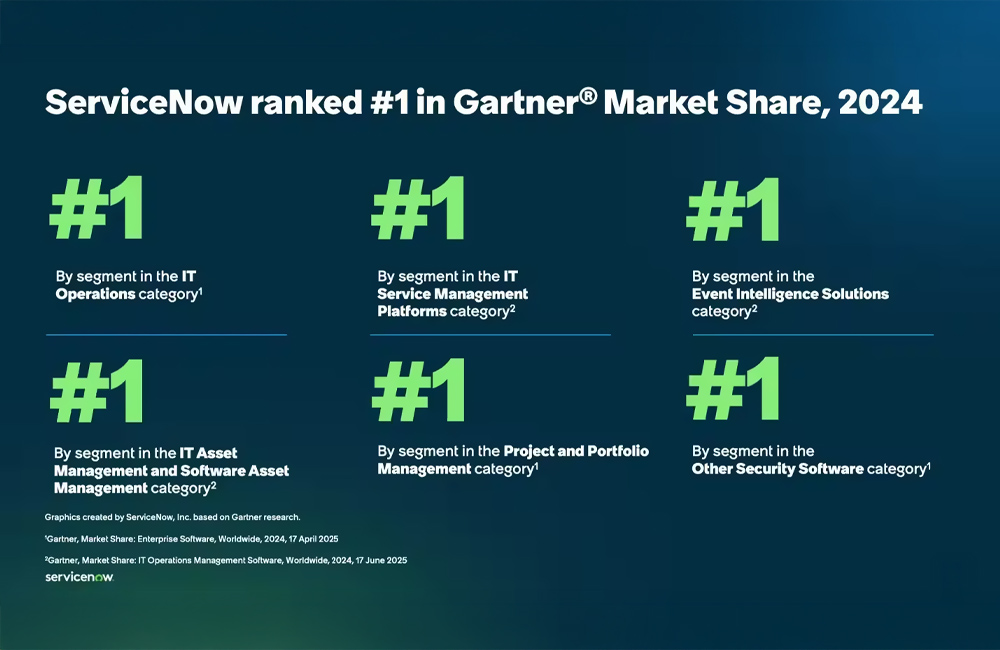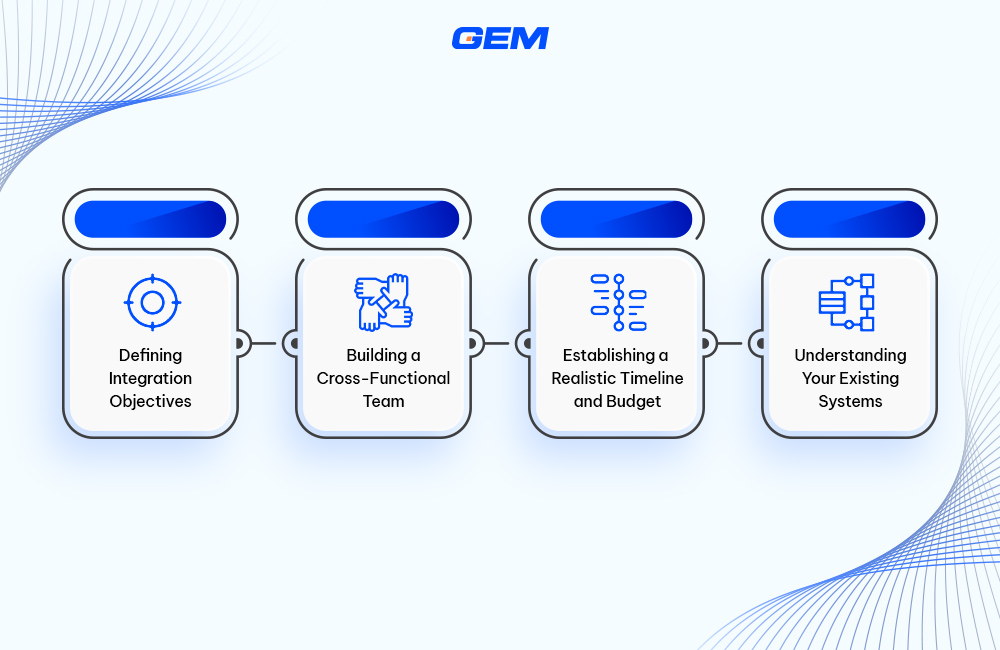Contents
- Common Challenges in ServiceNow Integration
- Strategic Planning Before ServiceNow Integration
- Choosing the Right ServiceNow Integration Method
- Managing Data and Security
- Testing and Driving Adoption
- Monitoring and Continuous Optimization
- Why You Need a ServiceNow Partner for Successful Integration
- GEM’s Approach to ServiceNow Integration and Services
- Conclusion
The value of ServiceNow integration continues to grow as more enterprises streamline operations with digital workflows. Yet integrating ServiceNow with legacy systems and distributed environments presents a range of operational, technical, and organizational challenges.
This article outlines key challenges, evaluates integration methods, and provides practical guidance for planning, execution, and long-term optimization. Whether you’re preparing for your first integration or refining an existing deployment, these insights will help you structure a more resilient ServiceNow environment.
Common Challenges in ServiceNow Integration

Source: Servicenow
With over 80% of Fortune 500 Best companies using the platform, ServiceNow is no longer optional for organizations seeking agility and process consistency.
While ServiceNow delivers broad functionality, integrating it into a complex IT landscape can introduce issues if not carefully managed. Below are the primary challenges organizations encounter during integration.
- Real-Time Data Gaps
Real-time visibility is a common integration goal, but achieving it can be difficult. Many organizations rely on third-party business intelligence tools to extend ServiceNow’s reporting functionality. When these tools are connected through custom APIs, data often arrives with delays due to limitations in query frequency or transfer intervals. This lag affects dashboards, reporting accuracy, and the ability to act on time-sensitive issues.
- System Performance Constraints
API-heavy integrations can impact the platform’s performance, particularly under high data volumes. Competing API calls during peak operating hours may slow down workflows or trigger failures. Without careful scheduling and load balancing, critical functions may be disrupted.
- Limited Internal Support
Many teams lack the technical skills needed to manage integrations across ServiceNow and external systems. This leads to inconsistent data flows, delayed issue resolution, and overreliance on external consultants. Staff turnover can further weaken continuity, particularly if documentation is outdated or unavailable.
- Over-Customization Risks
ServiceNow is designed to be configurable, but excessive customization makes upgrades more difficult and adds support overhead. Custom scripts may require rework with each platform update. This not only slows down innovation but also increases maintenance costs.
- Security Vulnerabilities
Integrating ServiceNow with third-party systems can expose data if APIs are not configured securely. Misconfigured authentication, open endpoints, and a lack of encrypted data paths can create vulnerabilities, especially in regulated industries.
Strategic Planning Before ServiceNow Integration

A successful ServiceNow integration begins with a structured planning phase. This includes aligning goals, building the right team, and understanding the technical environment.
Defining Integration Objectives
The integration should serve clear business objectives. Whether the goal is to improve service resolution times, automate request handling, or gain visibility into asset usage, defining measurable outcomes is essential. These goals guide decision-making throughout the integration process, from selecting tools to configuring data flows, and provide a basis for evaluating success post-launch.
Building a Cross-Functional Team
ServiceNow integration typically spans multiple departments, so stakeholder alignment matters. Involving IT operations, application owners, business teams, and external partners early in the process helps avoid disconnects later. Each group brings different insights – technical, operational, and strategic, that contribute to a more holistic design. Continuous communication across these groups supports faster decision-making and reduces friction during implementation.
Establishing a Realistic Timeline and Budget
Timelines and budgets should reflect the complexity of the integration. A phased approach, beginning with high-priority systems, often yields better results than an all-at-once deployment. The budget needs to account not just for licensing or platform fees, but also for consulting support, training, and contingency resources. Setting expectations clearly from the outset helps maintain accountability and minimizes scope creep.
Understanding Your Existing Systems
Before making any changes, it’s necessary to map the current environment. This includes reviewing system documentation, conducting interviews with system owners, and analyzing data structures. Understanding how each system stores, processes, and secures data allows integration architects to design more effective connections. It also reveals potential bottlenecks or compatibility issues that may require remediation before integration begins.
Read more: Discover how ServiceNow CSM enhances customer workflows and cross-team collaboration for a seamless service experience.
Choosing the Right ServiceNow Integration Method
Selecting the right integration approach depends on your systems, resources, and business goals. Below are the three most common methods used with ServiceNow.
API-Based Integration
This method involves using ServiceNow’s APIs and integration tools to connect with external systems. It offers the greatest level of control and supports real-time data exchange, making it suitable for complex or high-frequency workflows.
Pros:
- Supports real-time transactions
- Offers detailed control over data structures and logic
- Secure communication protocols such as OAuth and token-based authentication
Cons:
- Requires development resources familiar with both ServiceNow and the external system
- Maintenance burden increases with complexity
- Can affect platform performance if not optimized
Web Services Integration
ServiceNow supports standard web services protocols that allow different applications to communicate. This method is ideal for systems that already expose services over REST or SOAP.
Pros:
- Easier to implement than writing custom API code
- Works well with systems that already use web services
- Built-in security features such as encrypted transmission
Cons:
- Limited in customization compared to direct API integrations
- SOAP can be slower and more resource-intensive than REST
Third-Party Integration Tools
Tools like MuleSoft, Dell Boomi, and ServiceNow IntegrationHub offer prebuilt connectors and low-code workflows. These platforms are especially useful for organizations seeking rapid deployment without extensive coding.
Pros:
- Accelerates integration timelines
- User-friendly interfaces reduce need for deep technical skills
- Often includes monitoring and error-handling features
Cons:
- May introduce vendor dependency
- Less flexible in handling edge cases or complex logic
- Additional licensing fees may apply
Evaluating the Right Fit
When choosing a method, consider the nature of your workflows, the volume of data, and the skills available within your team. Organizations with strong development capabilities may prefer APIs for their flexibility, while those prioritizing speed and simplicity may find integration tools more effective.
Read more: Explore how ServiceNow HRSD streamlines employee journeys with integrated, automated HR workflows.
Managing Data and Security
Data integrity and security are foundational to successful ServiceNow integration. Poor data quality leads to unreliable reporting and broken workflows. Without proper safeguards, sensitive information may be exposed during transfer.
Data Cleansing and Standardization
Before connecting systems, it’s necessary to clean and normalize your data. This process involves removing duplicates, correcting errors, and aligning naming conventions. For example, equipment names or location codes should follow a consistent taxonomy across platforms. This ensures that data exchanges are accurate and meaningful once integration is live.
Standardization also helps streamline data mapping. When fields follow consistent formats, it becomes easier to match them between systems and reduce transformation logic. This clarity leads to faster implementation and fewer runtime issues.
Strengthening Security During Integration
ServiceNow includes features like role-based access control, audit logs, and data encryption. These should be configured carefully to limit exposure of sensitive records. During integration, additional protections may be needed depending on your industry or compliance obligations.
Key practices include:
- Using encrypted tokens for API authentication
- Restricting access based on user roles and system functions
- Implementing endpoint monitoring to detect unauthorized activity
These steps reduce the risk of data breaches and ensure that your integration strategy aligns with internal policies and external regulations.
Stop trying to find the dots. Let us help you connect them! With GEM as your ServiceNow Partner, accelerate delivery, reduce complexity, and gain a competitive edge in today’s fast-changing market.
Testing and Driving Adoption
Technical success does not guarantee business value. Proper testing and a focus on user adoption are essential to realizing the full benefits of ServiceNow integration.
Structured Testing Frameworks
Testing should occur in multiple stages. Unit tests validate each integration component in isolation. Integration tests confirm that connected systems pass data correctly under various conditions. Finally, user acceptance testing (UAT) involves real users validating workflows against real-world scenarios.
Each phase should be documented, with clear pass/fail criteria and issue resolution tracking. This disciplined approach minimizes surprises during go-live and builds confidence among stakeholders.
Supporting User Adoption
Training and communication are central to adoption. Users need to understand how the integration improves their daily tasks. Provide clear documentation, conduct onboarding sessions, and offer channels for feedback. Early engagement helps users feel involved and more likely to embrace the new system.
Monitoring and Continuous Optimization
Once integration is live, it requires ongoing oversight. System updates, changing business needs, and evolving data models all introduce new variables over time.
Monitoring Key Metrics
Regular monitoring helps detect issues before they affect performance. Important metrics include data sync status, API response times, and error logs. Use monitoring tools to visualize these metrics and set alerts for anomalies. This proactive approach helps sustain performance and reliability.
Adapting to Platform Changes
ServiceNow releases two major updates annually. These may affect custom scripts, integrations, or workflows. To maintain compatibility, test updates in staging environments and validate critical functions before deploying to production. Maintain a version history of integration logic to simplify rollback or rework when needed.
Read more: Discover how ITSM and ITOM work together to strengthen service reliability across integrated systems.
Why You Need a ServiceNow Partner for Successful Integration
ServiceNow’s capabilities extend far beyond IT ticketing, but unlocking its full potential requires more than platform access. Integration is often where projects slow down or shift off course. Working with a certified ServiceNow partner provides both operational support and strategic alignment, particularly in environments where legacy systems, regulatory requirements, or multi-department workflows introduce complexity.
Reasons to Engage a ServiceNow Partner

- Depth of Platform Expertise
Certified ServiceNow partners bring specialized knowledge across modules and integration scenarios. Whether implementing ITOM or aligning CMDB with external asset systems, partners offer practical insight into configuration standards, performance limits, and architectural decisions that affect long-term scalability.
- Cross-Industry Implementation Experience
Partners with a portfolio across sectors, such as healthcare, financial services, or manufacturing, understand different regulatory and operational contexts. This experience helps anticipate business risks during integration, such as data residency, audit readiness, or SLA alignment.
- Faster Time to Value
With pre-built frameworks, automation libraries, and tested methodologies, partners shorten the deployment timeline. This accelerates ROI by reducing trial-and-error cycles and internal resource strain.
- Risk Mitigation During Complex Integrations
Integrating ServiceNow into fragmented legacy ecosystems often requires reconciliation of inconsistent data models, security configurations, and access rules. Partners help reduce integration risk through structured governance, data validation plans, and fallback mechanisms.
- Long-Term Platform Stewardship
Beyond initial deployment, experienced partners provide guidance on change management, user adoption, and phased platform expansion. This is especially important for organizations aiming to scale from ITSM into HR, CSM, or GRC modules over time.
Efficient Processes When Collaborating with a ServiceNow Partner
Successful outcomes depend not just on selecting a partner but also on how the engagement is structured. The following practices support efficient collaboration:
Define Ownership Early
Clarify roles between internal teams and the partner across architecture, development, testing, and go-live. A shared RACI model helps avoid misalignment during delivery.
Document Business and Technical Requirements in Parallel
Partners can only deliver aligned outcomes when both business objectives and system-level constraints are clearly documented. Maintain traceability between integration specifications and business use cases.
Use Agile Delivery Frameworks
Break down integration into manageable sprints, with working demos and iterative feedback loops. This de-risks complex workflows and supports faster decision-making.
Establish a Single Integration Governance Layer
Create a joint steering committee to oversee timelines, issue resolution, and scope changes. This structure ensures accountability across both internal and external teams.
Plan for Transition and Knowledge Transfer
Ensure that integration knowledge – scripts, data maps, error-handling logic, is documented and handed off to internal teams post-launch. This supports sustainability after the project concludes.
Questions to Ask Your ServiceNow Partner
To gauge fit and alignment, consider asking the following during partner evaluation or engagement planning:
- What modules and industries have you implemented ServiceNow integrations for in the past 24 months?
- How do you approach performance testing and monitoring in high-volume integration environments?
- What frameworks or tools do you use for data mapping and transformation?
- How do you handle integration rollbacks or failure recovery?
- What is your approach to documentation, handoff, and post-launch support?
As ServiceNow continues to evolve toward a unified platform for digital operations, the role of a strategic partner becomes more central to long-term platform success.
GEM’s Approach to ServiceNow Integration and Services
GEM Corporation delivers ServiceNow solutions that are tailored to complex enterprise environments. As a certified ServiceNow partner, GEM supports organizations in deploying and scaling key modules across IT, HR, customer service, risk, and field operations. The focus is not just on configuration, but on building integrated workflows that align with business priorities.
Our delivery model covers the full lifecycle, from initial scoping and architecture planning to post-deployment optimization. Clients rely on GEM to support a wide range of modules, including IT Service Management (ITSM), IT Operations Management (ITOM), IT Asset Management (ITAM), Customer Service Management (CSM), Human Resources Service Delivery (HRSD), and Governance, Risk, and Compliance (GRC).
Each engagement is grounded in real-world operations. Whether replacing fragmented legacy systems, building secure integrations, or deploying AI-driven automation, GEM prioritizes outcomes over features. With a team of over 400 professionals and deep experience across regulated industries such as banking, healthcare, manufacturing, and telecom, GEM helps clients turn ServiceNow into a unified system of action that supports scale, transparency, and operational speed.
Conclusion
ServiceNow integration demands a structured approach, cross-functional collaboration, and continuous optimization. By anticipating challenges, choosing suitable integration methods, and investing in data quality and user experience, organizations can build resilient systems that scale with their needs.
To learn how GEM Corporation supports enterprise ServiceNow integration across IT, HR, customer service, and security workflows, CONTACT OUR TEAM for a consultation.
How do I determine which ServiceNow integration method is most suitable for my company?
The right method depends on your technical environment and goals. API-based integrations offer flexibility but require development expertise. Web services provide standardization and are easier to manage. Third-party integration tools are suitable when time-to-deploy and usability are the priority. Evaluating your internal capabilities and long-term maintenance needs is key to selecting the right approach.
Why is over-customization a problem during ServiceNow integration?
While customization allows for tailored workflows, excessive or undocumented changes can complicate platform upgrades and increase maintenance costs. Over-customized environments are harder to scale and often require manual intervention during updates, which slows down innovation.
What steps should be taken before starting the integration process?
A thorough assessment of existing systems, clear definition of business goals, stakeholder alignment, and a validated data model are all foundational. Investing time in these steps improves cross-system mapping, reduces rework, and ensures the integration reflects operational needs.
How does GEM support ServiceNow integration projects?
GEM provides full-cycle implementation services, from planning and module selection to deployment and optimization. Our teams help clients integrate ServiceNow with legacy systems, address security and data quality requirements, and build scalable workflows. Post-launch, GEM continues to support adoption and platform expansion aligned with the client’s strategic objectives.






